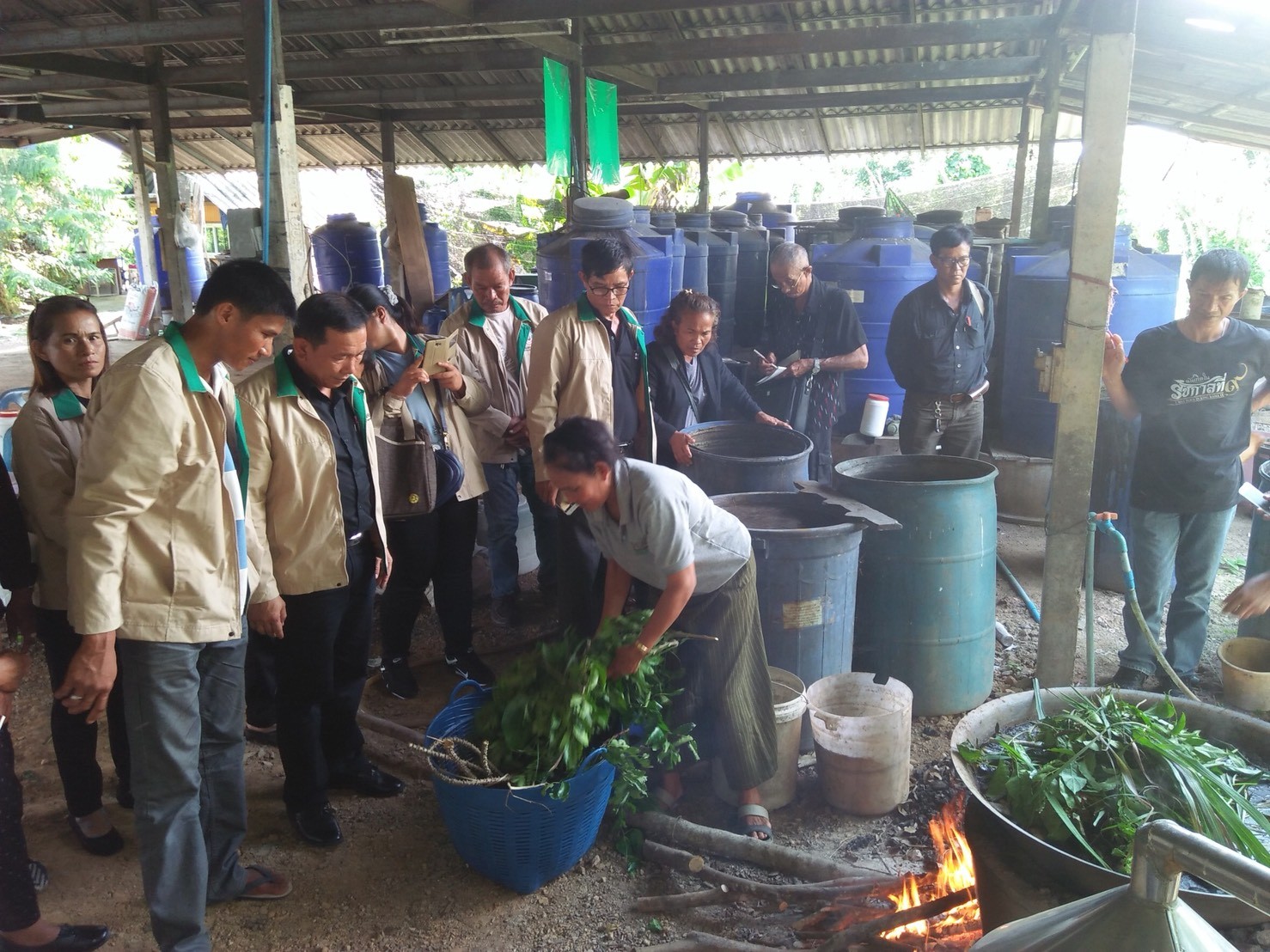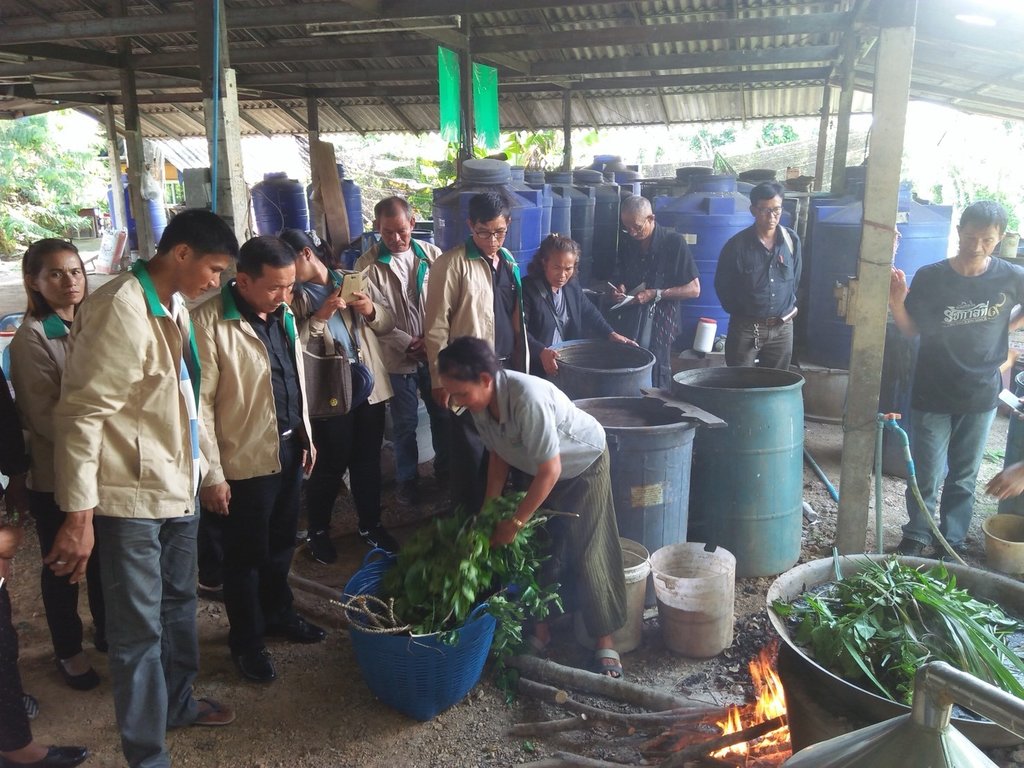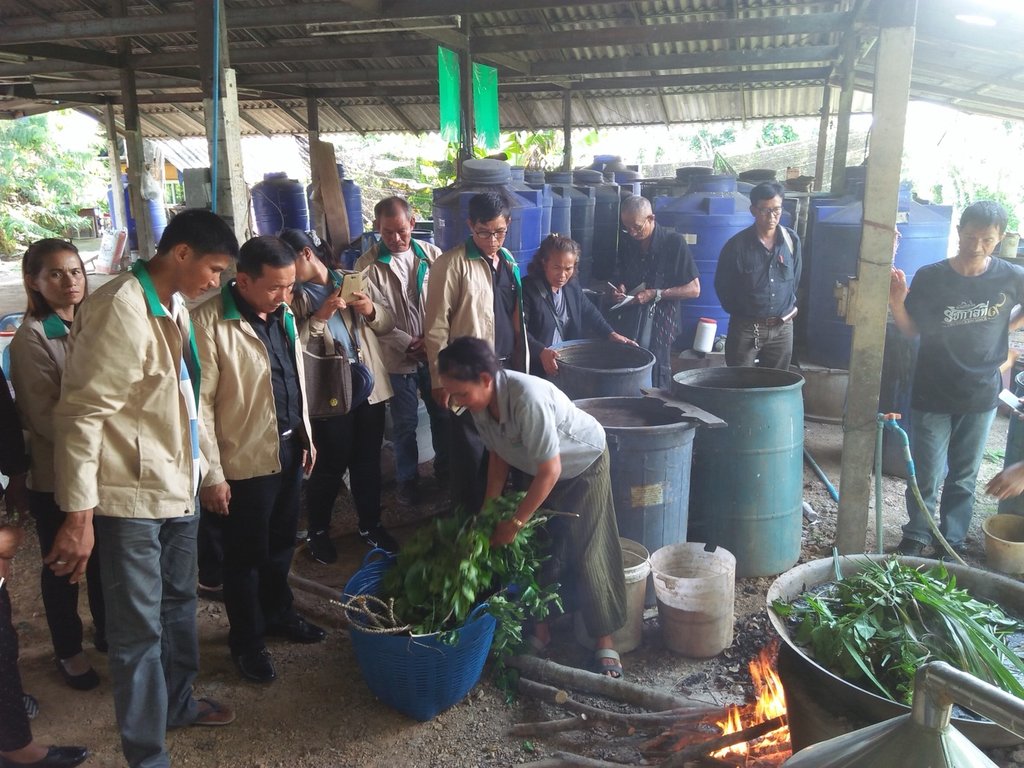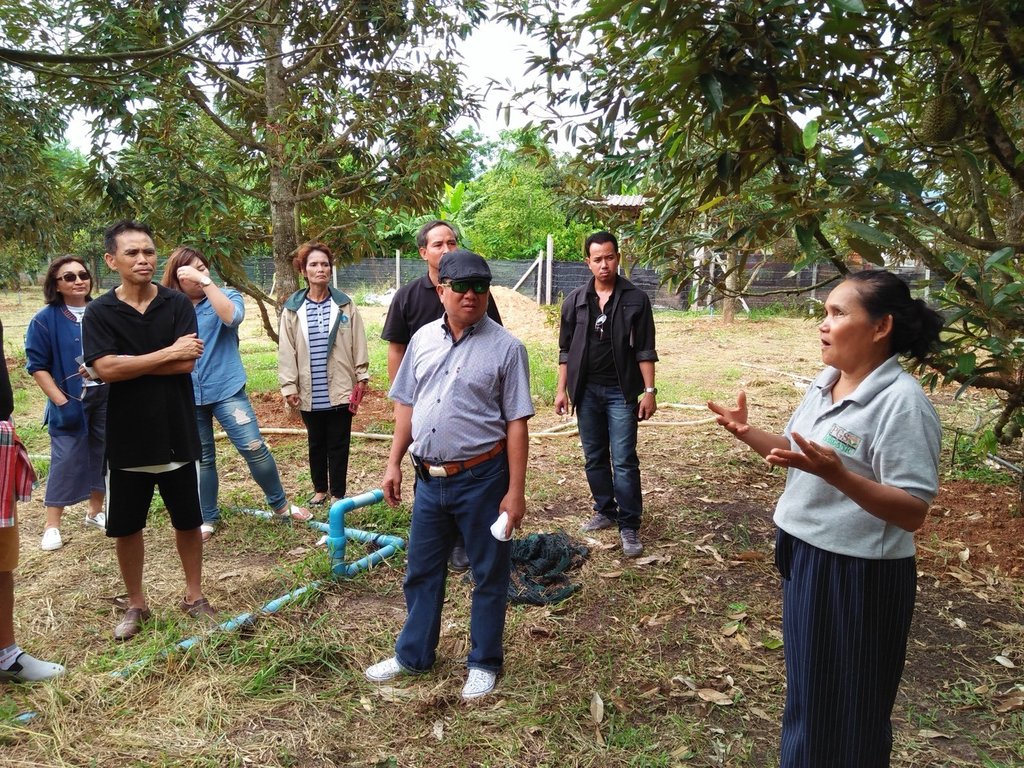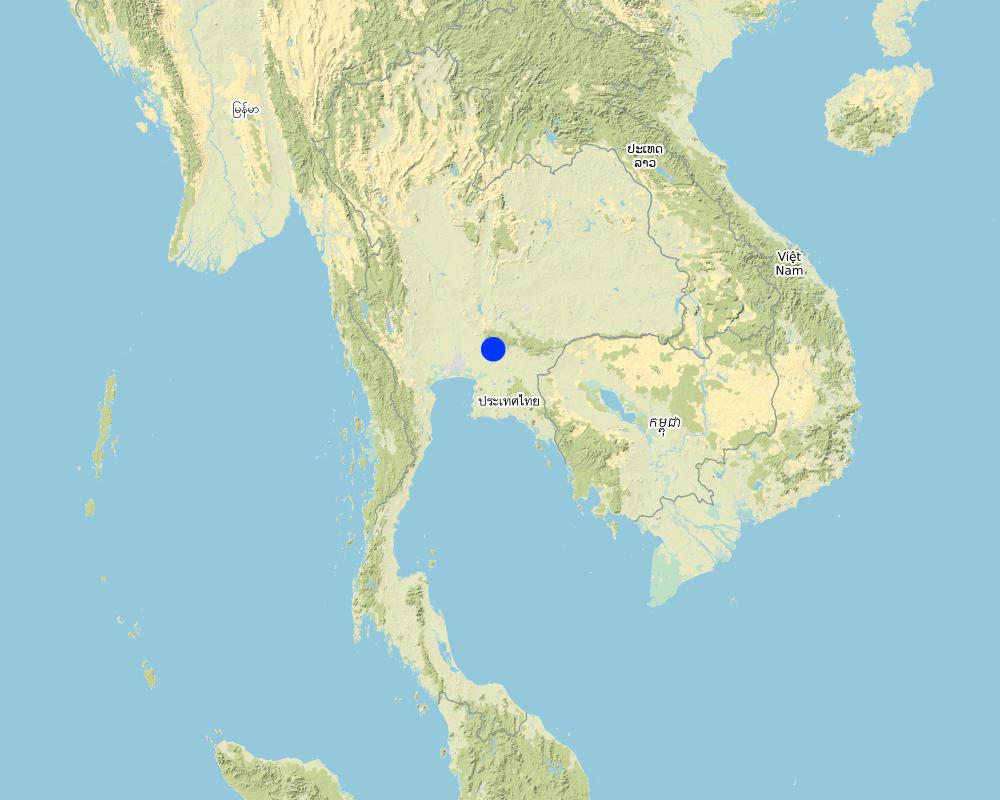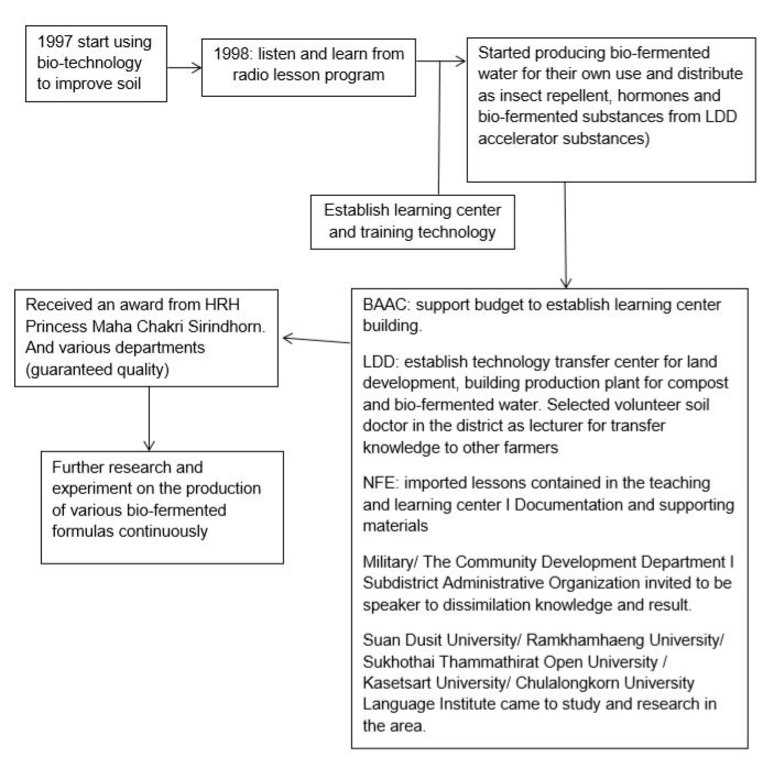Learning Center of Bio-fermentation Technology for Soil Improvement (Thailand) [Thailand]
- Creation:
- Update:
- Compiler: Kukiat SOITONG
- Editor: –
- Reviewers: Rima Mekdaschi Studer, William Critchley
Land Development Learning Center at Maiket District
approaches_4234 - Thailand
View sections
Expand all Collapse all1. General information
1.2 Contact details of resource persons and institutions involved in the assessment and documentation of the Approach
Key resource person(s)
land user:
ผู้รวบรวม:
Sonloy Wanpen
037-405026 / 081-8034930
parichat19@hotmail.com / -
Prachinburi Land Development Station LAnd Developemnt Department
62/1 Moo 5 Tambon Maiket ,Muang District ,Prachinburi province 25230,THAILAND
Thailand
land user:
ผู้อำนวยการศูนย์การศึกษานอกระบบและการศึกษาตามอัธยาศัยอำเภอเมืองปราจีนบุรี ผู้นำแนวทางเอสแอลเอ็ม ไปถอดบทเรียนเพื่อจัดทำหลักสูตรการเรียนการสอน และหลักสูตรการฝึกอบรมในองค์กร และเผยแพร่ประชาสัมพันธ์:
Laowongwathana Somboon
0-3721-3261 / 08-1723-0421
- / -
Informal education Center Prachinburi province
-Ratchdamri road 5 Namuang Subdistrict, Muang District Prachinburi province 25230
Thailand
officer:
Duangphim Kanok
09-5253-5982 / -
- / -
Term Sap Garden MaiKet Home Stay
27/2 Moo 2 Tambol Maiket ,Muang District Prochinburi province 25230
Thailand
land user:
Phomsuk Aroon
09-8893-0860 / -
- / -
เกษตรกร
42/2 Moo 5 Tambon MAiket,Muang District Prachinburi province 25230
Thailand
land user:
Boonyong Man
08-7128-7051 / -
- / -
ร.2 พัน.1 รอ.
45/2 Moo 5 Tambon MAiket,Muang District Prachinburi province 25230
Thailand
Boonyong Man
08-7128-7051 / -
- / -
ร.2 พัน.1 รอ.
45/2 Moo .5 Tambon Maiket Muang District Prochinburi province
1.3 Conditions regarding the use of data documented through WOCAT
When were the data compiled (in the field)?
28/09/2018
The compiler and key resource person(s) accept the conditions regarding the use of data documented through WOCAT:
Yes
2. Description of the SLM Approach
2.1 Short description of the Approach
The Learning Center of Bio-fermentation Technology for Soil Improvement at Maiket Sub-Muang PrachinBuri District, Prachinburi Province, covers the production and usage of a bio-fermented solution to improve the soil, and is the center for the network of the users.
2.2 Detailed description of the Approach
Detailed description of the Approach:
The Bio-fermentation technology Transferring Centre for the Soil Improvement at Mai ket district, Muang Prachin Buri is the source of learning about the production and usage of the bio-fermented solution that improves soils. It serves as a network centre also. The owners of the centre are knowledgeable and proud researchers who are ready to transfer that knowledge to the farmers in neighbouring communities: they are good trainers. Apart from study and research, activities and processes at the centre are:
1. Selecting farmers who are successful in producing and using Bio-fermentation technology
2. Public relations through a PR centre: VDO photography, Youtube, TV shows, radio programs.
3. Developing learning points and demonstration plots.
4. Providing training through visits by government agencies, the private and educational institutions. Supporting farmers interested in self studying as well as being traiers lecturer on and off the premises.
5. Establishing a bio-fermentation technology user network for farmers who come to study. The government has provided support.
6. Providing a learning forum emhasising learning together and technology transferring.
7. Promoting and developing the production and use of biotechnology
8. Selling products such as seedlings (durian), products (durian, longkong, banana, climbing wattle, etc.) and biological extracts.
The stakeholders comprise:
- The farmer who is the owner of the centre and has the role of researching, experimenting and developing technology, and technology transfer.
- The students who included farmers, soil experts, students and government officers.
- The manufacturers and users of technology who learn how to buy and sell.
- Customers that buy the fruits / fruits / vegetables and various extracts.
- Promoters such as government officers.
2.3 Photos of the Approach
2.4 Videos of the Approach
Comments, short description:
The Use of Bio Technology for Sustainable Land Management.
Date:
07/03/2018
Location:
-
Name of videographer:
LDD
Comments, short description:
Model Volunteer Soil Doctor on Organic agriculture.
Date:
05/07/2016
Location:
-
Name of videographer:
กรมพัฒนาที่ดิน
2.5 Country/ region/ locations where the Approach has been applied
Country:
Thailand
Region/ State/ Province:
Prachinburi
Further specification of location:
62/1 Moo 5Mai ket district, Muang Prachin Buri Sub-district
Comments:
-
Map
×2.6 Dates of initiation and termination of the Approach
Indicate year of initiation:
2000
Comments:
Initiative from the presentation of her lesson learn via army radio program in the year 2000
2.7 Type of Approach
- recent local initiative/ innovative
2.8 Main aims/ objectives of the Approach
The purpose of the center is to convey the technology of production and use of bio-fermented solution to the farmers and general public and to build a network of users of the biotechnology to improve the soil.
2.9 Conditions enabling or hindering implementation of the Technology/ Technologies applied under the Approach
social/ cultural/ religious norms and values
- enabling
Sharing and helping each other is a local tradition.
availability/ access to financial resources and services
- enabling
There are funding resources in the community.
institutional setting
- enabling
Established as a “Land development technology transfer center” by LDD.
legal framework (land tenure, land and water use rights)
- enabling
Financial and training inputs supported by MOAC, LDD.
policies
- enabling
Organic production under the government policy
land governance (decision-making, implementation and enforcement)
- enabling
Organic production under the government policy
ไม่เป็นระบบ ดูแลไม่ทั่วถึง ได้รับการสนับสนุนปัจจัย แต่เกษตรกรไม่มีความรู้ในเรื่อง การนำไปใช้ และการพัฒนาต่อยอด
knowledge about SLM, access to technical support
- enabling
A number of public sector agencies support and promote the subjects and the technology transfer.
markets (to purchase inputs, sell products) and prices
- enabling
There is a market that has potential in selling safe food and related products.
workload, availability of manpower
- enabling
The bio-fermentation technology transfer centers gives an idea of how to apply the low cost and food safety technology,
3. Participation and roles of stakeholders involved
3.1 Stakeholders involved in the Approach and their roles
- local land users/ local communities
Local community, neighbours, farmers all over the country, and interested persons
Training, study tours, field visits
- community-based organizations
Local administration organization
Agro-tourist site was developed
- SLM specialists/ agricultural advisers
Land Development Department
Work closely with those assigned to be soil doctors, to be farmer trainers/ speaker, under the LDD’s Soil Doctors training program.
- teachers/ school children/ students
Informal education center
Learned the lesson and selected the bio-fermentation technology to be in the training curriculum for the center
- private sector
The Bank of Agriculture and Agricultural Cooperatives (BAAC)
Supported the budget for constructing the building of the center
หน่วยงานพัฒนาของทหาร
-
If several stakeholders were involved, indicate lead agency:
-
3.2 Involvement of local land users/ local communities in the different phases of the Approach
| Involvement of local land users/ local communities | Specify who was involved and describe activities | |
|---|---|---|
| initiation/ motivation | self-mobilization | Ms Wanpen Sonloy has become popular/ well known via the media, such as radio, TV program. LDD supports the micro-organisms inoculum, molasses and containers. |
| planning | interactive | LDD compost the inputs for the Learning Center. |
| implementation | interactive | LDD supports the compost warehouse, composts inputs, bio-fermentation inputs, soil amendment materials, poster or sign board, VDO. The Bank of Agriculture and Agricultural Cooperatives (BAAC) supports funding for constructing the center. |
| monitoring/ evaluation | interactive | Informal Education Center/ LDD monitors and evaluates the center. |
3.3 Flow chart (if available)
3.4 Decision-making on the selection of SLM Technology/ Technologies
Specify who decided on the selection of the Technology/ Technologies to be implemented:
- land users alone (self-initiative)
Explain:
Land user
Specify on what basis decisions were made:
- evaluation of well-documented SLM knowledge (evidence-based decision-making)
4. Technical support, capacity building, and knowledge management
4.1 Capacity building/ training
Was training provided to land users/ other stakeholders?
Yes
Specify who was trained:
- land users
- field staff/ advisers
If relevant, specify gender, age, status, ethnicity, etc.
Training and technology transfer to all visitors as farmers, teachers ,students, and others interested persons
Form of training:
- farmer-to-farmer
- demonstration areas
- public meetings
Subjects covered:
Life-long learning project, organic fertilizer production and project to promote its use.
Comments:
-
4.2 Advisory service
Do land users have access to an advisory service?
Yes
Specify whether advisory service is provided:
- at permanent centres
- facebook suanwanpen panmai
Describe/ comments:
Interested farmers can consult both at the center and facebook page “suanwanpen panmai”
4.3 Institution strengthening (organizational development)
Have institutions been established or strengthened through the Approach?
- no
4.4 Monitoring and evaluation
Is monitoring and evaluation part of the Approach?
Yes
If yes, is this documentation intended to be used for monitoring and evaluation?
Yes
4.5 Research
Was research part of the Approach?
No
5. Financing and external material support
5.1 Annual budget for the SLM component of the Approach
If precise annual budget is not known, indicate range:
- 100,000-1,000,000
Comments (e.g. main sources of funding/ major donors):
BAAC supported 100,000 Baht for the center building. LDD supported the compost warehouse and related equipment.
5.2 Financial/ material support provided to land users
Did land users receive financial/ material support for implementing the Technology/ Technologies?
Yes
If yes, specify type(s) of support, conditions, and provider(s):
LDD supported the compost warehouse and related equipment
5.3 Subsidies for specific inputs (including labour)
- agricultural
| Specify which inputs were subsidised | To which extent | Specify subsidies |
|---|---|---|
| Fermentation tank, molasses | partly financed | |
- construction
| Specify which inputs were subsidised | To which extent | Specify subsidies |
|---|---|---|
| stone | partly financed | BAAC supported 100,000 Baht for the center building. |
| wood | partly financed | - |
| Tiles, cement, construction steel. | partly financed | - |
- other
| Other (specify) | To which extent | Specify subsidies |
|---|---|---|
| พด. 15,000 บาท (สนับสนุนในรูปปัจจัยการผลิตน้ำหมักชีวภาพ) |
If labour by land users was a substantial input, was it:
- rewarded with other material support
Comments:
-
5.4 Credit
Was credit provided under the Approach for SLM activities?
No
5.5 Other incentives or instruments
Were other incentives or instruments used to promote implementation of SLM Technologies?
Yes
If yes, specify:
The center sells its own products, there is honorarium, it is well known and popular, with good recognition.
6. Impact analysis and concluding statements
6.1 Impacts of the Approach
Did the Approach empower local land users, improve stakeholder participation?
- No
- Yes, little
- Yes, moderately
- Yes, greatly
The center will encourage the community and make them try to be self-reliant, such as about farm inputs.
Did the Approach enable evidence-based decision-making?
- No
- Yes, little
- Yes, moderately
- Yes, greatly
The visitors get a better understanding from the center documents and demonstration field.
Did the Approach help land users to implement and maintain SLM Technologies?
- No
- Yes, little
- Yes, moderately
- Yes, greatly
The visitors adopted the technology easily after they have learned the lesson from the real practices of the center.
Did the Approach improve coordination and cost-effective implementation of SLM?
- No
- Yes, little
- Yes, moderately
- Yes, greatly
Public sector and their network learn the lesson, up-scale their involvement, then monitor and evaluate.
Did the Approach mobilize/ improve access to financial resources for SLM implementation?
- No
- Yes, little
- Yes, moderately
- Yes, greatly
The public sector supports the fund, farm inputs, etc.
Did the Approach improve knowledge and capacities of land users to implement SLM?
- No
- Yes, little
- Yes, moderately
- Yes, greatly
A large number of farmers visit the center frequently through the involvement of the public sector, making the innovator stimulated with further development of the technology.
Did the Approach improve knowledge and capacities of other stakeholders?
- No
- Yes, little
- Yes, moderately
- Yes, greatly
The consultation is made through many channels such as phone, Line, Facebook, etc.
Did the Approach build/ strengthen institutions, collaboration between stakeholders?
- No
- Yes, little
- Yes, moderately
- Yes, greatly
The network of visitors cooperate to transfer and develop the use of the technology.
หากการใช้เทคโนโลยีชีวภาพในฟาร์ม มีการขยายผลมากขึ้น จะช่วยลดการปนเปื้อนสารพิษ/สารเคมีทางการเกษตรในระบบนิเวศน์ บรรเทาความขัดแย้งของคนในชุมชน
Did the Approach empower socially and economically disadvantaged groups?
- No
- Yes, little
- Yes, moderately
- Yes, greatly
The visitors belong to various groups (gender, age, disabled).
Did the Approach encourage young people/ the next generation of land users to engage in SLM?
- No
- Yes, little
- Yes, moderately
- Yes, greatly
A large number of visitors with wide scope of their careers
ผลิตอาหารปลอดภัย แก่ผู้บริโภค
Did the Approach improve access to markets?
- No
- Yes, little
- Yes, moderately
- Yes, greatly
Production of safe food makes better market.
Did the Approach lead to employment, income opportunities?
- No
- Yes, little
- Yes, moderately
- Yes, greatly
The network members are encouraged to be self-reliant.
6.2 Main motivation of land users to implement SLM
- increased production
better soil make better yield
- increased profit(ability), improved cost-benefit-ratio
increase farmers income /cost reduction
- reduced land degradation
The technology is able to
restore land degradation
- environmental consciousness
environmental friendly of the organic approach of the technology
- enhanced SLM knowledge and skills
Self learning and development
6.3 Sustainability of Approach activities
Can the land users sustain what has been implemented through the Approach (without external support)?
- yes
If yes, describe how:
Land users are able to apply the technology by themselves because most of the inputs for the technology are available in their farm/community.
6.4 Strengths/ advantages of the Approach
| Strengths/ advantages/ opportunities in the land user’s view |
|---|
| The center of broadcasting that is a great way to learn how to practice to solve problems in the occupation. |
| The farmer-owner of the center is a researcher herself. It has become a prototype farm for interested farmers. |
| Ensuring the professionalism of the technology user community. (The network provides advice/ guidance, such as the formula to make the operation profitable.) |
| Make the opportunity to meet and exchange information with each other. |
| Establishing the learning center, study trips, practices, and to practice provides suitable technology to solve career problems. |
| Strengths/ advantages/ opportunities in the compiler’s or other key resource person’s view |
|---|
| The farmer-owner of the center is able to answer clearly to the trainees/ visitors because she has learned from her own practice and experiments. |
| Farmers have their own experiences and better understanding to explain from their learning by doing. |
| - |
6.5 Weaknesses/ disadvantages of the Approach and ways of overcoming them
| Weaknesses/ disadvantages/ risks in the land user’s view | How can they be overcome? |
|---|---|
| The limited number of The Bio-fermentation technology Transferring Centers for Soil Improvement | There should be more learning centers to transfer the technology. |
| Farmers have no interest in the technology | The government sectors should set up awareness raising activities to show the public. |
| - | - |
| Weaknesses/ disadvantages/ risks in the compiler’s or other key resource person’s view | How can they be overcome? |
|---|---|
| Lack of research and technical support for the technology | should do more research. |
| - | - |
| - | - |
7. References and links
7.1 Methods/ sources of information
- field visits, field surveys
-
- interviews with land users
5
- compilation from reports and other existing documentation
local wisdom Knowledge transferring document
7.2 References to available publications
Title, author, year, ISBN:
-
Available from where? Costs?
-
7.3 Links to relevant information which is available online
Title/ description:
-
URL:
-
Links and modules
Expand all Collapse allLinks
No links
Modules
No modules


